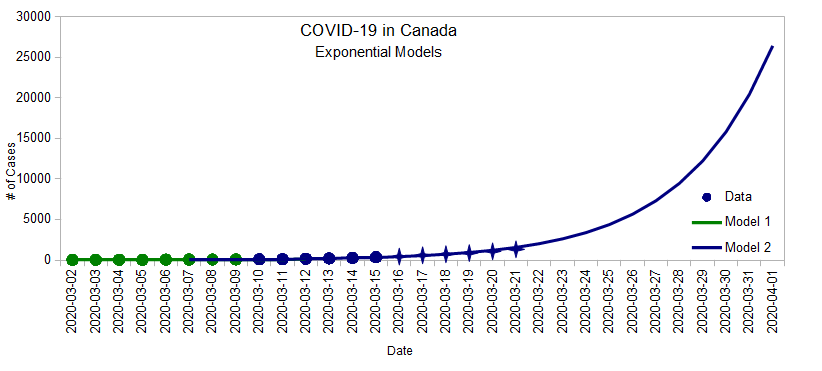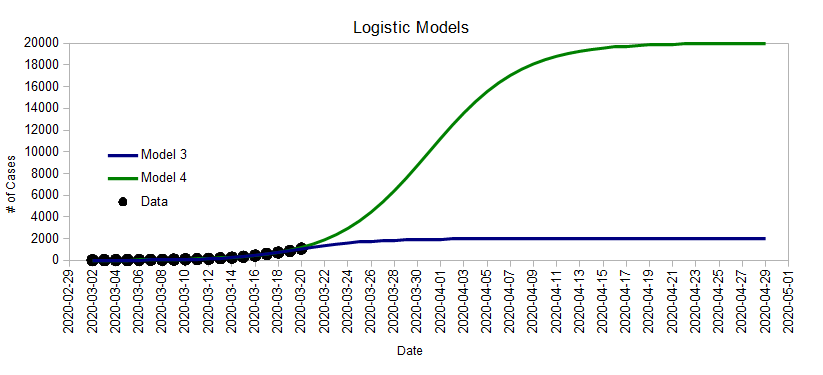This is an old revision of the document!
Table of Contents
COVID-19 Spread (Part II)
- I'm not an epidemiologist, doctor, or any kind of expert on the subject. I just look at the numbers.
In Part I I built an exponential model using data between March 2 and March 15, then continued to add daily numbers to see how that model tracked:
| Date | Count | Date | Count | Date | Count | ||
|---|---|---|---|---|---|---|---|
| 2020-03-01 | ? | 2020-03-08 | 64 | 2020-03-15 | 342 | ||
| 2020-03-02 | 27 | 2020-03-09 | 77 | 2020-03-16 | 441 | ||
| 2020-03-03 | 27 | 2020-03-10 | 95 | 2020-03-17 | 596 | ||
| 2020-03-04 | 33 | 2020-03-11 | 117 | 2020-03-18 | 727 | ||
| 2020-03-05 | 37 | 2020-03-12 | 157 | 2020-03-19 | 873 | ||
| 2020-03-06 | 48 | 2020-03-13 | 201 | 2020-03-20 | 1087 | ||
| 2020-03-07 | 60 | 2020-03-14 | 254 | 2020-03-21 | 1331 |
Initially, the number of cases doubled every 2.7 days, predicting almost 1600 cases by the end of Saturday, but in the last two or three days, the rate of infection seems to have slowed down a bit, which is what I'm exploring here.
Growth Rate
There's a ratio involving three data points that's useful to track how “fast” the exponential is. It's easier to explain with an example. Suppose we had three days like this:
| Day | # of Cases | New Cases | Growth Rate |
|---|---|---|---|
| Day 1 | 100 | ||
| Day 2 | 110 | 10 | |
| Day 3 | 130 | 20 | 2 |
COVID-19 Spread (Part I)
So there's a very real sense in which, if we don't do anything different, we could simply be about 15 days behind Italy...
But doing the right things can change that future. In reality, the spread of the infection follows more of a Logistic Function. At the beginning, it looks like an exponential, but then it flattens out. This is what the news keeps referring to when they say that social distancing and proper hand washing can help “flattening the curve” more quickly.
 The real question is how soon will we reach that middle point, and at what height.
The real question is how soon will we reach that middle point, and at what height.
Here's a good video that explains this sort of math and why being able to think in exponential term is important for non-linear systems such as this one.
And here's another one with different animations that complements it very nicely.
Here's an interesting article from The Washington Post showing basic random simulations for four different cases (free-for-all, attempted quarantine, mild moderate distancing, extensive social distancing).

More on the Logistic Function
This is an update from March 19th.
This section illustrates how eventhough the infection follows a Logistic Function, that fact alone doesn't necessarily help us predict the future. For example, here are two very different models that fit the current data pretty well:
The equation for “Model 3” is:
$$N = \frac{2000}{1 + e^{-0.32(t - 21.1)}}$$
It reaches its halfway point around March 21 and peaks at 2000 people infected. Unfortunately, “Model 4” also fits the data just as well:
Its equation is:
$$N = \frac{20000}{1 + e^{-0.24(t - 32)}}$$
But it reaches its halfway point at on April 1st and peaks at 20,000 people.
Reality could be anywhere in between, or even higher ‒ I could have easily created a curve that fits the current data just as well and peaks at 2 million people. The point is that we just don't know because it all depends on how we act now.




